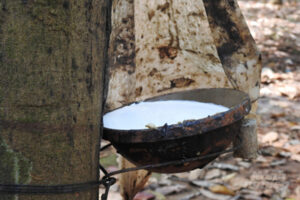Researchers find temperature differences influence rubber latex yield
Xishuangbanna , China – In a study published in International Journal of Biometeorology, researchers from the Xishuangbanna Tropical Botanical Garden (XTBG) of the Chinese Academy of Sciences (CAS) and the Kunming Institute of Botany of CAS examined the effects of temperature, phenology, and powdery mildew disease on rubber latex yield in March using observational data on daily rubber latex yield combined with detailed phenology, powdery mildew, and temperature data from 2004 to 2010 at a state-owned farm in the Xishuangbanna, Yunnan, China.
The researchers found that the daily temperature difference from January to March was the most important factor influencing rubber latex yield, surpassing both rubber phenology and powdery mildew disease. In addition, rubber phenology during defoliation and re-foliation (November to March) was found to be critical for rubber latex yield.
Daily temperature variation had both direct and indirect effects on rubber latex yield. Temperature indirectly influenced yield by altering the duration of leaf development to maturation and exposure it to powdery mildew disease.
“This study is the most comprehensive quantitative assessment of the relationship and the potential linkages between rubber latex yield and rubber leaf defoliation phenology, powdery mildew disease, and temperature,” said Zhai Deli of XTBG.
The researchers recommended that future experiments on rubber latex yield, latex physiology and leaf diseases should cover both defoliation and re-foliation periods.

